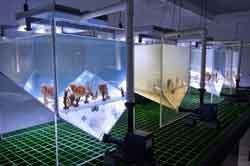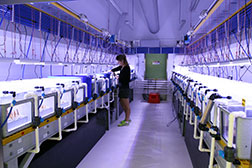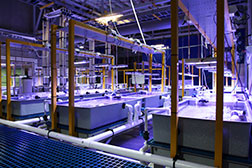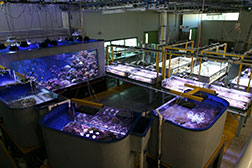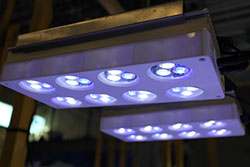SeaSim integrates technology used in the industrial process sector with best practice from the aquarium sector to enable large-scale experimental research not previously possible in Australia.
SeaSim can:
- control complex combinations of environmental variables to accurately simulate both naturally occurring and human-influenced water conditions
- undertake long-duration, multi-organism experiments (particularly corals, sponges and seagrasses) in large-scale tanks with precise control over seawater conditions
- increase knowledge rates through the development of model marine organisms, with the current focus on corals and coral reproduction.
Seawater processing
This world-class seawater system creates high-quality, reliable seawater year round for the entire SeaSim facility. This system includes:
- forty-three seawater pumps (14 supply and processing pumps and 29 in the building) capable of delivering 3 million litres of seawater daily
- incoming seawater filtered to 0.04µm to ensure it is consistently of high quality
- separate lines to deliver raw seawater to the facility
- real-time water quality monitoring that uses SMS to alert users to any water quality changes immediately
- large seawater storage capacity that enables experiments to continue during temporary outages.
Services
All experimental spaces have access to the following services:
- ambient temperature filtered seawater
- 22 °C filtered seawater
- 36 °C filtered seawater
- freshwater
- unfiltered seawater
- 15 °C unfiltered seawater
- 40 °C unfiltered seawater
- CO2 gas lines
- mixed CO2/air
- ability to control experimental seawater to any temperature between 22 °C and 36 °C with an accuracy of ±0.1 °C, including the ability to set daily or seasonal profiling
- state-of-the-art lighting with control of periodicity and intensity.
Experimental spaces
SeaSim has a range of large, state-of-the-art spaces available for marine science researchers. Many services (such as water temperature control and pH/pCO2 manipulation) are modular and therefore customisable to the requirements of individual projects.
Controlled environment rooms
These include:
- eight controlled environment rooms ranging in size from 6 x 7m to 4 x 7m
- constant air temperature in each room with less than ±0.5 °C variation
- sophisticated controls system
- monitoring and logging of environmental parameters, accessible remotely
- automated alarms with messaging sent via SMS
- process controls of parameters such as pH, temperature and lighting
- automation of process functions.
Controlled environment rooms for out-of-season spawning
These include:
- a large open-plan flexible space that can be configured into three large, controlled environment rooms
- manipulation of environmental parameters such as temperature, lighting and moon light cycles to shift the natural spawning cycles of model marine organisms (such as corals and crown-of-thorns starfish)
- larval grow-out and early life-history stage nursery facilities.
Indoor open-plan experiment area
This includes:
- 350 m2 of air-conditioned open-plan space with artificial lighting for long-term, large tank multi-species studies under tightly controlled conditions
Outdoor open-plan experiment area
This includes:
- 400 m2 of open-plan space with ambient temperature and lighting allowing for long-term, large tank, multi-species studies under ambient conditions
- state-of-the-art acrylic sheeting that allows full-spectrum sunlight (including ultra violet light) to penetrate the experimental area.
Key technologies
pH/CO2 manipulation
Industrial level controls and sensors are used to manipulate the pH/pCO2 of flowing seawater. Key components of the system include ISFET pH probes, Liqui-cel membrane contactors and mass flow controllers.
Temperature controls
Automatic mixing of 22 °C and 36 °C seawater provides ‘on-tap' water temperatures within this range to ±0.1 °C. Heat exchanger systems enable the delivery of temperature controlled seawater with an accuracy of ±0.1 °C.
Control system
Advanced controls and monitoring systems are centralised and enable remote monitoring of experiments through networked devices. A data historian ensures all data on experimental parameters are recorded.
Lighting
SeaSim lighting systems use plasma and LED lighting and controls that can simulate daily and seasonal changes in light intensity. This fine level of control can be used to manipulate lighting or emulate natural lighting conditions.
Experimental tanks
Experimental tank sizes range from 20 litres to large, multi-species tanks for long-term studies─which can be up to 3000 litres. These can also be custom made for studies requiring larger units.
Support facilities
Existing research and infrastructure facilities at the AIMS Cape Ferguson headquarters complement and support research at SeaSim. These include: laboratories with chemical and bioanalytical capability, data management facilities, engineering workshops, extensive microscopy facilities, organic geochemistry and radioisotope laboratories, and research vessels.
Click here for a print version of the floor plan.


